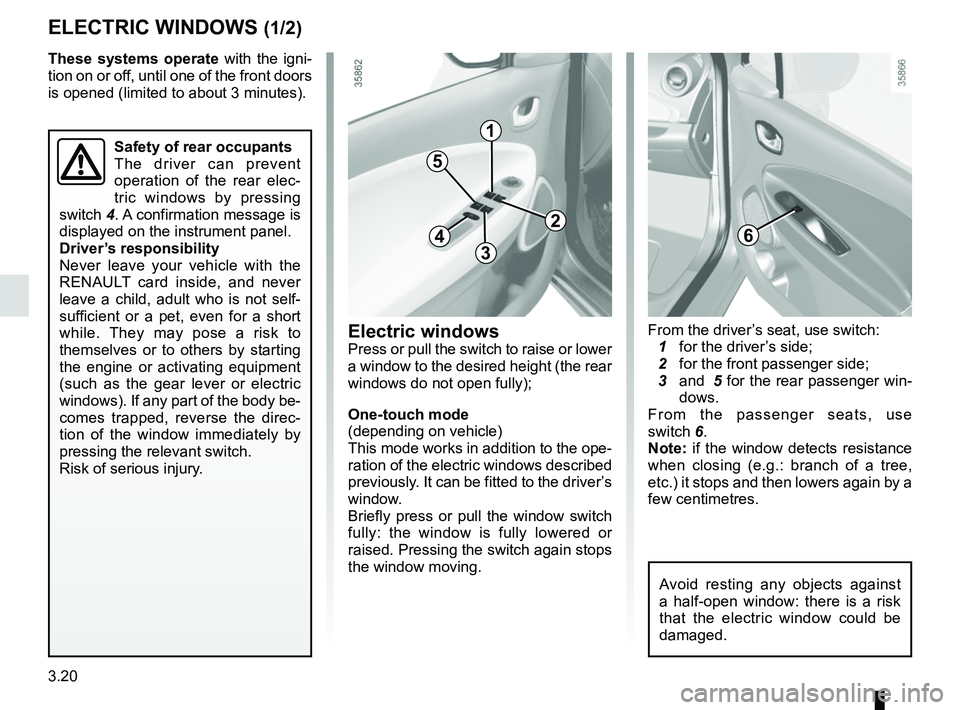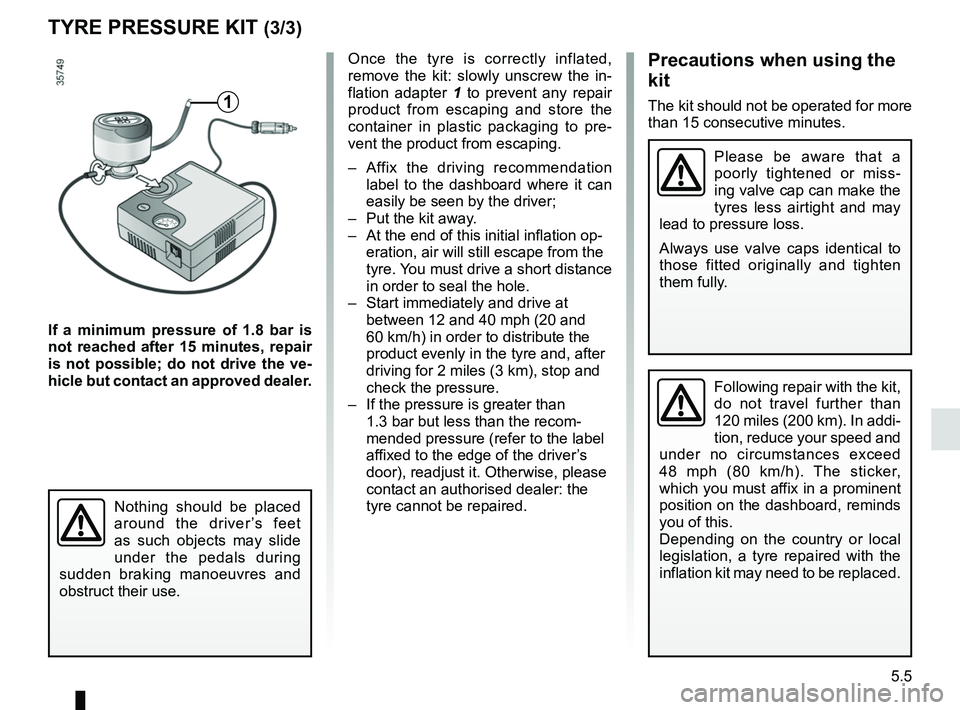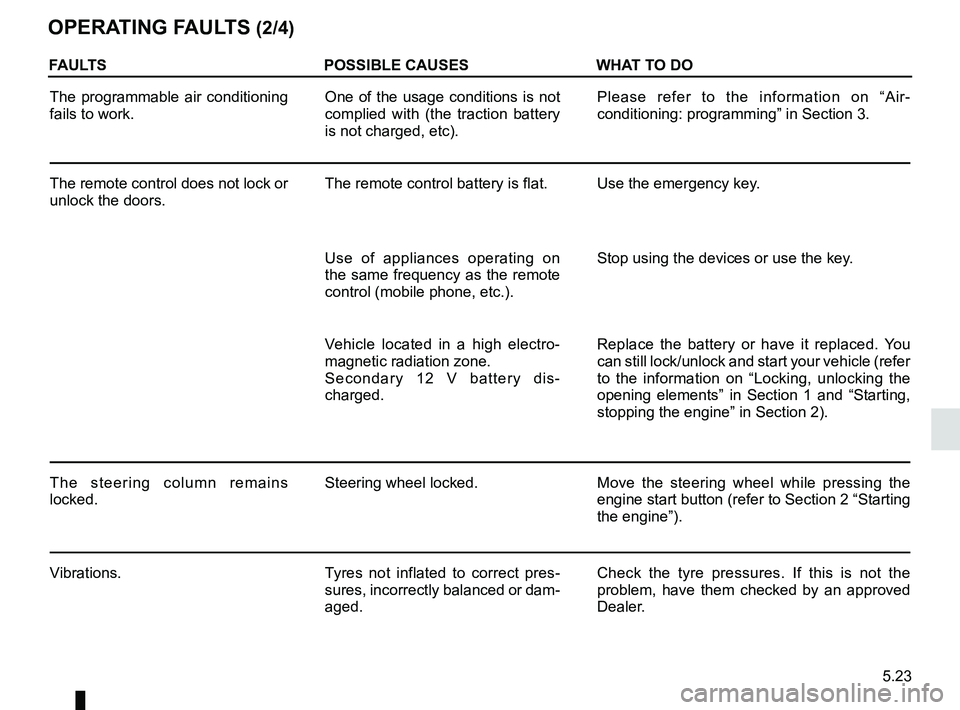stop start RENAULT ZOE 2018 Owner's Guide
[x] Cancel search | Manufacturer: RENAULT, Model Year: 2018, Model line: ZOE, Model: RENAULT ZOE 2018Pages: 226, PDF Size: 5.51 MB
Page 146 of 226

3.20
Safety of rear occupants
The driver can prevent
operation of the rear elec-
tric windows by pressing
switch 4. A confirmation message is
displayed on the instrument panel.
Driver’s responsibility
Never leave your vehicle with the
RENAULT card inside, and never
leave a child, adult who is not self-
sufficient or a pet, even for a short
while. They may pose a risk to
themselves or to others by starting
the engine or activating equipment
(such as the gear lever or electric
windows). If any part of the body be-
comes trapped, reverse the direc-
tion of the window immediately by
pressing the relevant switch.
Risk of serious injury.
ELECTRIC WINDOWS (1/2)
These systems operate with the igni-
tion on or off, until one of the front doors
is opened (limited to about 3 minutes).
From the driver’s seat, use switch:
1 for the driver’s side;
2 for the front passenger side;
3 and 5 for the rear passenger win-
dows.
From the passenger seats, use
switch 6.
Note: if the window detects resistance
when closing (e.g.: branch of a tree,
etc.) it stops and then lowers again by a
few centimetres.Electric windowsPress or pull the switch to raise or lower
a window to the desired height (the rear
windows do not open fully);
One-touch mode
(depending on vehicle)
This mode works in addition to the ope-
ration of the electric windows described
previously. It can be fitted to the driver’s
window.
Briefly press or pull the window switch
fully: the window is fully lowered or
raised. Pressing the switch again stops
the window moving.
1
2
34
5
6
Avoid resting any objects against
a half-open window: there is a risk
that the electric window could be
damaged.
Page 179 of 226

5.5
TYRE PRESSURE KIT (3/3)
If a minimum pressure of 1.8 bar is
not reached after 15 minutes, repair
is not possible; do not drive the ve-
hicle but contact an approved dealer.
Once the tyre is correctly inflated,
remove the kit: slowly unscrew the in-
flation adapter 1 to prevent any repair
product from escaping and store the
container in plastic packaging to pre-
vent the product from escaping.
– Affix the driving recommendation label to the dashboard where it can
easily be seen by the driver;
– Put the kit away.
– At the end of this initial inflation op- eration, air will still escape from the
tyre. You must drive a short distance
in order to seal the hole.
– Start immediately and drive at between 12 and 40 mph (20 and
60 km/h) in order to distribute the
product evenly in the tyre and, after
driving for 2 miles (3 km), stop and
check the pressure.
– If the pressure is greater than 1.3 bar but less than the recom-
mended pressure (refer to the label
affixed to the edge of the driver’s
door), readjust it. Otherwise, please
contact an authorised dealer: the
tyre cannot be repaired.Precautions when using the
kit
The kit should not be operated for more
than 15 consecutive minutes.
Nothing should be placed
around the driver’s feet
as such objects may slide
under the pedals during
sudden braking manoeuvres and
obstruct their use.
1
Please be aware that a
poorly tightened or miss-
ing valve cap can make the
tyres less airtight and may
lead to pressure loss.
Always use valve caps identical to
those fitted originally and tighten
them fully.
Following repair with the kit,
do not travel further than
120 miles (200 km). In addi-
tion, reduce your speed and
under no circumstances exceed
48 mph (80 km/h). The sticker,
which you must affix in a prominent
position on the dashboard, reminds
you of this.
Depending on the country or local
legislation, a tyre repaired with the
inflation kit may need to be replaced.
Page 194 of 226

5.20
Once you have finished towing, press
the engine start button twice (risk of
running down the 12 V battery).
If the lever is stuck in P, even though
you are depressing the brake pedal, the
lever can be released manually.
To do this, unclip the cover at the base
of the lever.
Simultaneously press at the location 7
and the unlocking button 6 on the lever.
TOWING, BREAKDOWN (2/3)
6
7
In the event of an energy
fault: towing
In the event of a fully discharged trac-
tion battery:
– the warning light 2
Ṏ flashes;
– the indicator 1 shows an empty bat-
tery.
It is possible to recover on a flatbed
truck or tow the vehicle using the tow
eye, following the instructions below.
When the engine is stop-
ped, steering and braking
assistance are not opera-
tional.
Before towing, unlock the steering
column: engage the lever 5 in posi-
tion N, insert the card in the reader 4
then press the engine starting button 3
for approximately two seconds.
The column is unlocked, the accessory
functions are supplied: the vehicle lights
can be used (hazard warning lights,
brake lights etc.). The towed vehicle’s
lights must be switched on at night.
The speed specified by current legisla-
tion for towing must always be obser-
ved.
3
5
4
1
2
Page 197 of 226

5.23
OPERATING FAULTS (2/4)
FAULTSPOSSIBLE CAUSESWHAT TO DO
The programmable air conditioning
fails to work. One of the usage conditions is not
complied with (the traction battery
is not charged, etc).Please refer to the information on “Air-
conditioning: programming” in Section 3.
The remote control does not lock or
unlock the doors. The remote control battery is flat. Use the emergency key.
Use of appliances operating on
the same frequency as the remote
control (mobile phone, etc.).Stop using the devices or use the key.
Vehicle located in a high electro-
magnetic radiation zone.
Secondary 12 V battery dis-
charged. Replace the battery or have it replaced. You
can still lock/unlock and start your vehicle (refer
to the information on “Locking, unlocking the
opening elements” in Section 1 and “Starting,
stopping the engine” in Section 2).
The steering column remains
locked. Steering wheel locked.
Move the steering wheel while pressing the
engine start button (refer to Section 2 “Starting
the engine”).
Vibrations. Tyres not inflated to correct pres-
sures, incorrectly balanced or dam-
aged. Check the tyre pressures. If this is not the
problem, have them checked by an approved
Dealer.
Page 222 of 226

7.4
ALPHABETICAL INDEX (4/5)
RENAULT cardbattery ................................................................\
.......... 5.15
use .......................................................... 1.18 → 1.26, 3.11
RENAULT card battery ...................................................... 5.15
replacement parts ................................................................ 6.6
reverse gear selecting ................................................................ 2.5 – 2.6
reversing sensor ..................................................... 2.28 – 2.29
S
screen wash/wipe .............................................................. 1.87
seat belt pretensioners ..........................................1.37 → 1.40
front seat belt ...................................................1.37 → 1.40
seat belts ..................................1.33 → 1.40, 1.42 – 1.43, 1.63
see-me-home lighting ............................................... 1.82, 1.84
service sheets..........................................................6.7 → 6.12
side protection devices ...................................................... 1.42
signals and lights ...................................................1.81 → 1.84
speakers location ...............................................................\
......... 5.16
speed control .............................................................. 2.5 – 2.6
speed limiter .................................................1.63, 2.21 → 2.23
spoiler ................................................................\
................ 3.31
starting ...............................................................\
........2.2 → 2.4
starting the engine .....................................................2.2 → 2.4
steering wheel adjustment .............................................................\
...... 1.77
stopping the engine ............................................................. 2.4
storage compartment.............................................3.23 → 3.25
storage compartments ...........................................3.23 → 3.25
sun visor ........................................................................\
.... 3.22
T
tailgate ...............................................................\
................ 3.31
tanks and reservoirs brake fluid ...................................................................... 4.5 coolant ................................................................\
........... 4.4
tanks and reservoirs: windscreen washer ........................................................ 4.5
technical specifications ........................................................ 6.6
telephone ..............................................................\
............. 3.33
temperature regulation ............................................3.4 → 3.10
tool kit ........................................................................\
.......... 5.2
towing in the event of energy failure ...........................5.19 → 5.21
breakdown .......................................................5.19 → 5.21
towing hitch...................................................... 5.2, 5.20 – 5.21
towing rings ................................................... 1.47 – 1.48, 3.32
traction battery ...........................................................1.2 → 1.6
traction battery charge .............................................1.8 → 1.15
traction control .......................................................2.16 → 2.20
transporting children ..........................1.44 – 1.45, 1.47 → 1.57
transporting objects in the luggage compartment ............................. 3.31 – 3.32
trip computer and warning system.........................1.67 → 1.74
tyre inflation kit...........................................................5.3 → 5.5
tyre pressure............................................2.13 → 2.15, 4.8, 5.7
tyre pressure loss warning.....................................2.13 → 2.15
tyre pressures ...................................................................... 4.8
tyres .............................................. 2.13 → 2.15, 4.8, 5.6 → 5.8
U
unlocking the doors ................................................ 1.29 – 1.30
V
vehicle range ........................................................... 2.7 → 2.11
ventilation ............................................................\
....3.4 → 3.10
W
warning buzzer ..................................... 1.27 – 1.28, 1.79, 1.82
warning lights.....................................1.62 →
1.64, 1.67 – 1.68
washing ................................................................\
... 4.9 → 4.11